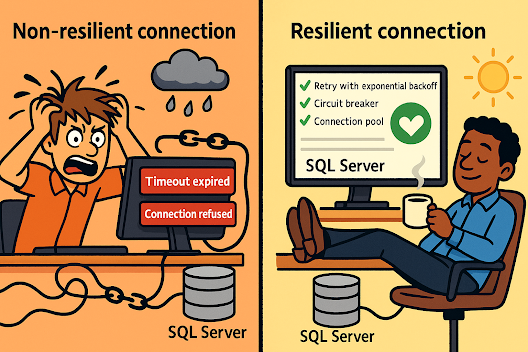Transient failures happen — in the cloud (Azure SQL) and on-prem. A resilient connection strategy lets your app recover gracefully instead of crashing: it waits smartly, retries safely, and doesn’t pound the database when it’s truly unavailable.
Why care?
-
Less downtime during patching/scaling/failovers
-
Smoother UX — fewer “please try again” moments for users
-
Operational robustness against brief network glitches and load spikes
-
Fewer cascading errors — keep transactions consistent and data clean
Transient vs. persistent errors
Transient errors (good candidates for retry):
-
Brief network interruptions
-
“Server busy”/throttling
-
Deadlocks or timeouts due to temporary load
-
Failovers during maintenance/patching
Persistent errors (should fail fast):
The point: classify the error, then do the right thing. Retries only help with transient faults.
Patterns you actually need
-
Retry with exponential backoff + jitter (spreads load to avoid stampedes)
-
Circuit Breaker (stop hammering when the DB is really down)
-
Connection pooling (reduce login churn, lower latency)
-
Timeouts & Cancellation (no infinite waits; play nice with callers)
-
Idempotency (retries must not create duplicates or corrupt state)
-
Always On optimization:
MultiSubnetFailover=Truein your connection string
Code: Async retry with backoff + jitter (C# / Microsoft.Data.SqlClient)
Below is a quick primer and a C# sample you can paste right in.
Usage
Production tips
-
Log with structure (attempt, backoff, error codes, correlation ID).
-
Bound retries (max attempts or a total time budget).
-
Make writes idempotent or wrap in transactions that tolerate retries.
-
Consider a Circuit Breaker (e.g., via Polly) around the most critical calls.
-
Windows auth.
-
Leverage SqlClient’s built-in retry (RetryLogicProvider) if you want a centralized policy.
Bottom line
Resilience isn’t a nice-to-have; it’s part of correctness in data access. With a thin layer of backoff-based retries, clear error classification, cancellation, and the right connection settings, your application will sail through the little storms that would otherwise dent availability and user experience.

